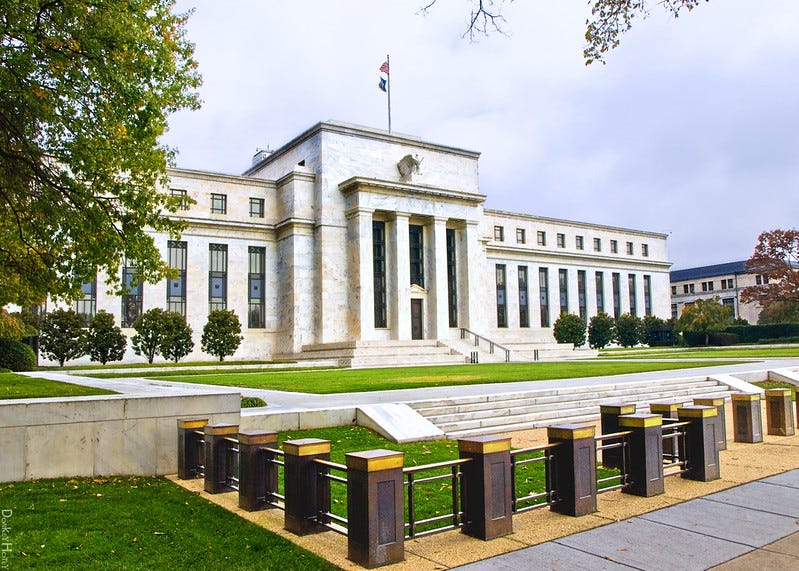The Fed Raised Rates... Again
What This Means For You
"Federal Reserve Building in Washington D.C. - Illustration" by DonkeyHotey is licensed under CC BY 2.0.
As expected, Jerome Powell and the gang at the Federal Reserve announced a .75 percentage point increase yesterday, bringing the federal funds rate to a target of 3.75-4%. Essentially, this means financial products with an interest rate attached to it are going up. Depending on your financial goals, this could be good and bad. Let’s dive into why, and what you should be looking to do next.
The federal funds rate is the target rate that banks borrow and lend excess reserves to each other overnight. This rate is important as it impacts the cost of borrowing through loans, as well as the interest that can be gained through financial instruments like savings accounts and CDs. Though the federal funds can have a lagging effect on the economy, you will often see some changes immediately (as evidenced by Ally sending me an email before the Fed announcement that my savings account increased again).
With all that being said, there are a few things to consider now that the rate has increased, and will likely continue to do so into 2023. Let’s start with debt.
If you have any high-interest debt (rates higher than 4%) look to pay that off immediately. This is especially true if that debt is at a variable rate. Whether student loans, credit cards, or a personal loan, there are ways to decrease this much faster. Many credit cards offer 0% balance transfer cards, meaning you can transfer your balance to this card and make payments without interest being tacked on. For personal or student loans, look to credit unions as a place to potentially refinance. They tend to offer lower rates than banks or traditional loan providers. Even if the rate seems high compared to a few months ago, your monthly payment and total spent over the life of the loan might be lower than what you’re currently paying. Sites like Lending Tree are a great resource to compare rates.
Rates will continue to go up. Don’t hesitate!
If you’re looking to park some money, whether for a specific goal or just to earn some interest, then you have plenty of options. The first place to look, if you don’t have one already, is a high-yield savings account. Personally, I prefer online banks to traditional banks with branches as they offer higher rates and make it easy to transfer to your main bank. We personally use Ally, but there are plenty of options. Currently, Marcus by Goldman Sachs offers the best interest rate, though I’m sure that will be matched or bested soon.
Online high-yield savings accounts are the perfect spot to put your emergency fund, as well as money you’re marking for specific goals. There are also a myriad of financial products to look into, with terms ranging from 4 weeks up to multiple years. Two of the products below are backed by the Federal Government (Treasury Bills and I Bonds), so you don’t have to worry about a lender defaulting on your purchase.
Treasury Bills - terms ranging from 4 weeks to 52 weeks
I Bonds - you cannot sell until you own for 12 months, but lose 3 months of interest if you sell before 5 years
CDs (Certificate of Deposit) - Earn interest for the entirety of the time period you buy for, but you cannot sell prior to or risk losing interest
A major purchase you still might be eyeing is a home. Last month 30-year mortgage rates hit 7%, the highest in two decades. Though they are dipping just below that now, they are still much higher than last year when everyone was offering bags of cash plus their soul for a home. This tweet from Genevieve Roch-Decter, who writes a great substack titled Grit Capital, explains it well.
In my view, unless you really need a new home, I think it’s best to stay put and continue to save for a larger down payment and other associated purchase costs. If you choose this route, it is also a good time to save for an even larger emergency fund for that home you plan to buy in the future. If you do plan to buy a home now, there’s a few things to consider. First, do you need the size of home you originally targeted? The $400,000 home you dreamed of last year might now be listed at $550,000, with a mortgage rate that has doubled. Second, it would also be prudent to evaluate your overall budget as your target mortgage payment could be higher than originally expected. See if there’s areas you’re paying for that you could do without. Or, better than cutting costs, look to bring in more income. Whether that be a side-hustle you can turn into a business, requesting a raise in your current job, or looking to find a higher-paying position.
These rate increases are going to continue into next year. Though you can’t control monetary policy, nor the economy as a whole, you can control how you respond. Taking action on the items above can put you in a much better position and prepare you for the future, no matter what Jay Powell and the gang do next.





